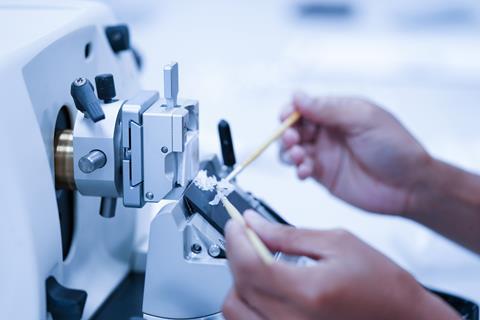I have been teaching microbiology for more than 25 years. During that time, I have seen it all – students who arrive eager to learn and others who attend because they have no other choice. Over the years, I have also taught various subjects at different times of day: sometimes early in the morning, other times late in the afternoon (or early evening, depending on how you look at it). Many of my colleagues would surely agree that some time slots are far better than others, but, generally speaking, we don’t get to choose them; they are assigned by the dean’s office. Students’ physical and mental states fluctuate throughout the day. Early mornings often favor concentration, while just before lunch is usually less ideal.
Every teacher develops their own strategies to capture students’ attention and spark engagement. Since I have always loved both cinema and microbiology, it seemed natural to combine these two passions. Inspired by Professor Feldman’s “Microbe Minute” I began using short film clips – what I call micro-clips – at the start of my classes. These clips are not from documentaries, but from commercial films familiar to the general public. Over time, I have compiled a list of movies that include microbiological themes. For years, I wrote monthly commentaries about them for the newsletter of the Spanish Society of Microbiology. I am now translating these into the English language for publication on the website of the Spanish node of the International Microbe Literacy Initiative (IMiLI), whose mission is to make microbiology knowledge accessible and relevant to the wider public.
Regarding bad microbes
We must admit that movies have greatly contributed to the image of microbes as villains, fueling widespread germophobia. Yet, as Oscar Wilde might say, even bad publicity is good publicity – at least people are talking about them. Commercial movies where infectious diseases appear can be used as engaging tools in the classroom or to address public health issues in disadvantaged populations. When I taught General Microbiology, pathogenic microbes featured prominently in the syllabus, so it was easy to find film examples dealing with infectious diseases. Here are a couple I have used in my classes:
Plague: If there is one disease synonymous with medieval films, it is the plague. Among the depictions, I particularly recommend Your Friend the Rat (Jim Capobianco, 2007), an animated short that, in less than three minutes, brilliantly explains how Yersinia pestis triggered the bubonic plague pandemic of 1347 –the “Black Death.” The film provides a classic example of zoonosis, showing how fleas (Xenopsylla cheopis) transmitted the bacterium from infected black rats (Rattus rattus) to humans once their rodent hosts had died.

Tuberculosis: This devastating disease has inspired countless literary and cinematic portrayals, from Alexandre Dumas’s The Lady of the Camellias – whose latest incarnation was Satine (Nicole Kidman) in Moulin Rouge! (Baz Luhrmann, 2001) – to biographical films about 19th-century figures such as Chopin and the Brontë sisters. Perhaps the most iconic depiction is Val Kilmer’s Doc Holliday in Tombstone (George P. Cosmatos, Kevin Jarre, 2003). These portrayals vividly capture the disease’s slow decline and symptoms – pallor, coughing, hemoptysis, fainting, and dyspnea. Interestingly, tuberculosis also inspired Dracula, one of the great icons of horror. Robert Pattinson’s portrayal as a vampire in the Twilight saga even echoes the disease’s spectral aesthetic.

Goofs and praises
I take great pleasure in analyzing famous films to spot microbiological inaccuracies – perfect opportunities to clarify real scientific concepts in class. One of my favorite mistakes appears in Mission: Impossible II (John Woo, 2000), where the superagent Ethan Hunt (Tom Cruise) watches a video describing the symptoms of infection by the genetically engineered “Chimera” virus. The footage alternates between scenes of an infected person and images of red blood cells being invaded and destroyed by the virus. One of the questions I often asked my students was whether a virus could replicate within red blood cells, followed by a discussion of the pathogens that indeed can, such as the malaria-causing protozoan.
I also enjoy finding the opposite: scenes where microbiology is portrayed with remarkable accuracy. Thankfully, this is becoming more common as filmmakers increasingly consult experts to ensure scientific realism. My favorite example comes from The Andromeda Strain (Robert Wise, 1971), which shows the preparation of samples for electron microscopy with great detail and accuracy. The director wisely sought advice from Caltech scientists, resulting in a strikingly authentic depiction of how samples are sectioned with a microtome and introduced into the chamber of a scanning electron microscope.

Profitable microbes
When I began teaching “Industrial Microbiology,” I faced a challenge. As mentioned earlier, most films portray microbes as villains. For many students, the word “microbe” instantly evokes diseases, pandemics, or even zombie hordes. Yet as microbiologists, we must show that these tiny beings are not only essential to life on Earth but also our allies – helping us produce food, medicine, energy, and even clean up the environment. Educating the public about these beneficial aspects is what we call “Positive Microbiology”. And since cinema shapes how we view the world, it is time to reclaim microbes’ good name.
Unfortunately, the positive side of microbiology is rarely depicted on screen – but not entirely absent. One film I frequently use in class is Mad Max Beyond Thunderdome (George Miller and George Ogilvie, 1985), as an introduction to biofuels and the concept of circular bioeconomy.
The Mad Max saga portrays a dystopian world where oil has vanished, and civilization has collapsed. Survivors form warring clans that battle for dwindling resources. In the third film, Max (Mel Gibson) reaches Bartertown, a trade hub seemingly ruled by Aunty Entity (Tina Turner). In reality, the town’s power comes from “the Master Blaster,” a duo comprising a giant and a brilliant dwarf engineer who operates an underground biogas plant that produces methane from pig manure. This methane powers the city – making Bartertown one of cinema’s earliest examples of a circular bioeconomy, highlighting waste-to-energy systems and the vital role of microbes in sustainability.
“As I often tell my students, if the apocalypse ever arrives, knowledge of methanogenic microbes may prove more valuable than gold.”
I use a micro-clip (from minute 15:00 to 16:30) where Aunty Entity explains the biogas plant’s operation to Max, as an engaging introduction to biofuels.

Continuing with the issue of economics and biotechnology, I often use two other films:
Extraordinary Measures (Tom Vaughan, 2010). Although not strictly about microbiology, it’s deeply rooted in biotechnology. The film recounts the founding of Novazyme, a biotechnology company that pioneered enzyme therapy for Pompe disease, and the story of its founder, John Crowley, who established it to help his children suffering from the condition. I use a short clip in which Harrison Ford’s character explains to Crowley (Brendan Fraser) how they are going to start their own company to develop the therapy and control the patents they generate, rather than leaving them in the hands of the university where he works. An excellent example to introduce the topic of biotech innovation and intellectual property.
Breaking the Mould (Peter Hoar, 2009). I also recommend students watch this entire film, which recounts how the discovery of penicillin was transformed into a widely available medicine through the work of Howard Florey, Ernst Chain, and Norman Heathley. I use a clip that introduces the design of the post-fermentation process, showing how they develop the organic phase extraction by adjusting the solution’s pH.
How microbes put food on our tables
Perhaps the most familiar example of “positive microbiology” in everyday life is food fermentation – especially wine. Films such as A Good Year (Ridley Scott, 2006) and Bottle Shock (Randall Miller, 2008) explore this world. However, I particularly recommend the Japanese anime Moyashimon (Yūichirō Yano, 2012), based on the manga of the same name. Japanese anime is immensely popular among young audiences, making it an ideal teaching tool. Although Moyashimon has been translated as Tales of Agriculture, a more accurate title would be “Tales of the Starter”, since “moyashi” refers to the cultivation of Aspergillus oryzae, to be used as a starter culture. The series, widely available on streaming platforms, covers many aspects of fermented foods – especially Japanese staples like miso, soy sauce, and sake – as well as broader topics such as wine production and the influence of microbiota in human health.

Microbiology for the little ones
Explaining tiny things to young kids can be a challenge – but also a joy. Children are naturally curious, but microbes, being invisible and intangible, can seem abstract to them. That’s why we must engage their imagination – a resource they have in abundance – to help them explore the unseen microbial world. From experience, I know that audiovisual materials are among the best tools for early education, though few films address microbiology in a child-friendly way.
In this regard, I have a soft spot for the film Horton Hears a Who! (Jimmy Hayward and Steve Martino, 2008). At first glance, it may seem like a simple children’s tale, but it carries a profound message. When it premiered, my daughters were six and eight years old, and this movie helped me explain what their dad actually did for a living. The story of Horton and the Whos teaches values such as equality and respect, regardless of origin or size. Scientifically, it also illustrates the “scale problem” in microbiology – how something so small that it cannot be seen can still exert a profound influence on our world. It reminds us that scientists, like the character of Mayor Ned, must design instruments to perceive realities beyond the naked eye – and that one of science’s greatest challenges is helping society appreciate the unseen complexity of our universe.
Final thoughts
Cinema is an art form, and as such, it appeals to our emotions. But it can also be used as a powerful educational tool. Paraphrasing Alice Catherine Evans, it allows us to go beyond the realm of our own perceptions. While most movies cast microbes as villains, some describe their importance for human activities. Using those films in the classroom fosters curiosity, sharpens critical thinking, and helps combat germophobia. Of course, preparation is key. The instructor must preview the film, design questions, identify errors, and connect scenes to the curriculum. But the effort pays off – students become more attentive, engaged, and, most importantly, begin to see microbes in a new light.
Acknowledgments
The author thanks the Spanish Society of Microbiology, ISABIAL, and the IMiLI network for supporting science communication and promoting microbiology outreach.
Further Reading
Sánchez-Angulo M. (2025) Positive Microbiology in the Movies. Microbial Biotechnology 18:e70085. doi: 10.1111/1751-7915.70085.
Timmis, K., J. E. Hallsworth, T. J. McGenity, et al. 2024. A Concept for International Societally Relevant Microbiology Education and Microbiology Knowledge Promulgation in Society. Microbial Biotechnology 17: e14456. doi: 10.1111/1751-7915.14456










No comments yet